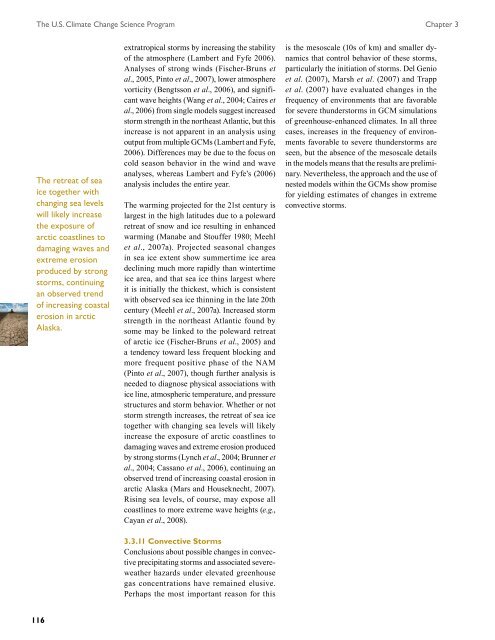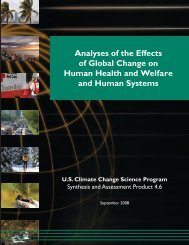Weather and Climate Extremes in a Changing Climate. Regions of ...
Weather and Climate Extremes in a Changing Climate. Regions of ...
Weather and Climate Extremes in a Changing Climate. Regions of ...
You also want an ePaper? Increase the reach of your titles
YUMPU automatically turns print PDFs into web optimized ePapers that Google loves.
The U.S. <strong>Climate</strong> Change Science Program Chapter 3<br />
The retreat <strong>of</strong> sea<br />
ice together with<br />
chang<strong>in</strong>g sea levels<br />
will likely <strong>in</strong>crease<br />
the exposure <strong>of</strong><br />
arctic coastl<strong>in</strong>es to<br />
damag<strong>in</strong>g waves <strong>and</strong><br />
extreme erosion<br />
produced by strong<br />
storms, cont<strong>in</strong>u<strong>in</strong>g<br />
an observed trend<br />
<strong>of</strong> <strong>in</strong>creas<strong>in</strong>g coastal<br />
erosion <strong>in</strong> arctic<br />
Alaska.<br />
116<br />
extratropical storms by <strong>in</strong>creas<strong>in</strong>g the stability<br />
<strong>of</strong> the atmosphere (Lambert <strong>and</strong> Fyfe 2006).<br />
Analyses <strong>of</strong> strong w<strong>in</strong>ds (Fischer-Bruns et<br />
al., 2005, P<strong>in</strong>to et al., 2007), lower atmosphere<br />
vorticity (Bengtsson et al., 2006), <strong>and</strong> significant<br />
wave heights (Wang et al., 2004; Caires et<br />
al., 2006) from s<strong>in</strong>gle models suggest <strong>in</strong>creased<br />
storm strength <strong>in</strong> the northeast Atlantic, but this<br />
<strong>in</strong>crease is not apparent <strong>in</strong> an analysis us<strong>in</strong>g<br />
output from multiple GCMs (Lambert <strong>and</strong> Fyfe,<br />
2006). Differences may be due to the focus on<br />
cold season behavior <strong>in</strong> the w<strong>in</strong>d <strong>and</strong> wave<br />
analyses, whereas Lambert <strong>and</strong> Fyfe’s (2006)<br />
analysis <strong>in</strong>cludes the entire year.<br />
The warm<strong>in</strong>g projected for the 21st century is<br />
largest <strong>in</strong> the high latitudes due to a poleward<br />
retreat <strong>of</strong> snow <strong>and</strong> ice result<strong>in</strong>g <strong>in</strong> enhanced<br />
warm<strong>in</strong>g (Manabe <strong>and</strong> Stouffer 1980; Meehl<br />
et al., 2007a). Projected seasonal changes<br />
<strong>in</strong> sea ice extent show summertime ice area<br />
decl<strong>in</strong><strong>in</strong>g much more rapidly than w<strong>in</strong>tertime<br />
ice area, <strong>and</strong> that sea ice th<strong>in</strong>s largest where<br />
it is <strong>in</strong>itially the thickest, which is consistent<br />
with observed sea ice th<strong>in</strong>n<strong>in</strong>g <strong>in</strong> the late 20th<br />
century (Meehl et al., 2007a). Increased storm<br />
strength <strong>in</strong> the northeast Atlantic found by<br />
some may be l<strong>in</strong>ked to the poleward retreat<br />
<strong>of</strong> arctic ice (Fischer-Bruns et al., 2005) <strong>and</strong><br />
a tendency toward less frequent block<strong>in</strong>g <strong>and</strong><br />
more frequent positive phase <strong>of</strong> the NAM<br />
(P<strong>in</strong>to et al., 2007), though further analysis is<br />
needed to diagnose physical associations with<br />
ice l<strong>in</strong>e, atmospheric temperature, <strong>and</strong> pressure<br />
structures <strong>and</strong> storm behavior. Whether or not<br />
storm strength <strong>in</strong>creases, the retreat <strong>of</strong> sea ice<br />
together with chang<strong>in</strong>g sea levels will likely<br />
<strong>in</strong>crease the exposure <strong>of</strong> arctic coastl<strong>in</strong>es to<br />
damag<strong>in</strong>g waves <strong>and</strong> extreme erosion produced<br />
by strong storms (Lynch et al., 2004; Brunner et<br />
al., 2004; Cassano et al., 2006), cont<strong>in</strong>u<strong>in</strong>g an<br />
observed trend <strong>of</strong> <strong>in</strong>creas<strong>in</strong>g coastal erosion <strong>in</strong><br />
arctic Alaska (Mars <strong>and</strong> Houseknecht, 2007).<br />
Ris<strong>in</strong>g sea levels, <strong>of</strong> course, may expose all<br />
coastl<strong>in</strong>es to more extreme wave heights (e.g.,<br />
Cayan et al., 2008).<br />
3.3.11 Convective Storms<br />
Conclusions about possible changes <strong>in</strong> convective<br />
precipitat<strong>in</strong>g storms <strong>and</strong> associated severeweather<br />
hazards under elevated greenhouse<br />
gas concentrations have rema<strong>in</strong>ed elusive.<br />
Perhaps the most important reason for this<br />
is the mesoscale (10s <strong>of</strong> km) <strong>and</strong> smaller dynamics<br />
that control behavior <strong>of</strong> these storms,<br />
particularly the <strong>in</strong>itiation <strong>of</strong> storms. Del Genio<br />
et al. (2007), Marsh et al. (2007) <strong>and</strong> Trapp<br />
et al. (2007) have evaluated changes <strong>in</strong> the<br />
frequency <strong>of</strong> environments that are favorable<br />
for severe thunderstorms <strong>in</strong> GCM simulations<br />
<strong>of</strong> greenhouse-enhanced climates. In all three<br />
cases, <strong>in</strong>creases <strong>in</strong> the frequency <strong>of</strong> environments<br />
favorable to severe thunderstorms are<br />
seen, but the absence <strong>of</strong> the mesoscale details<br />
<strong>in</strong> the models means that the results are prelim<strong>in</strong>ary.<br />
Nevertheless, the approach <strong>and</strong> the use <strong>of</strong><br />
nested models with<strong>in</strong> the GCMs show promise<br />
for yield<strong>in</strong>g estimates <strong>of</strong> changes <strong>in</strong> extreme<br />
convective storms.




